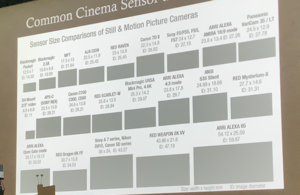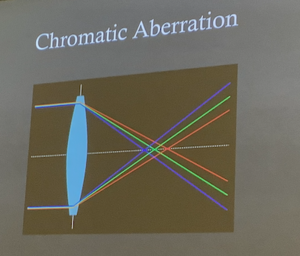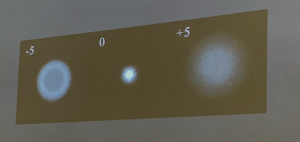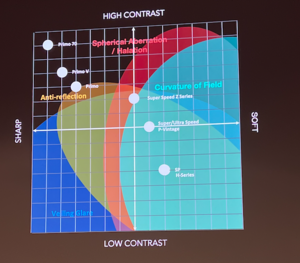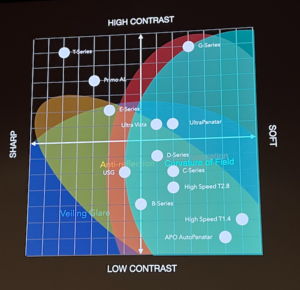Lens Characteristics
There are a number of characteristics of a lens.
Focal Length
This is basically how much the lens sees, but it can be affected by the size of the sensor. An example is a 50mm lens, 50mm is the focal length. It is defined as the distance between the lens's optical center (or principal point) and the image sensor or film plane when the lens is focused at infinity. In simple terms, focal length is part of what determines the magnification and angle of view of a lens.
Focal length will never change depending on the camera the lens is used on, but the angle of view may change depending on the sensor size.
Field of View vs. Angle of View
Field of view (FOV) and angle of view (AOV) are related concepts that describe the extent of the scene that a lens can capture. While they are used interchangeably in some contexts, they can have slightly different meanings depending on the context.
Field of view generally refers to the actual physical area or width of the scene that is visible through the camera lens. It is typically measured in linear units, such as meters or feet, and represents the total width of the scene that the lens can capture. For example, a wide-angle lens might have a larger field of view, allowing you to capture a broader scene in your photograph.
Angle of view, on the other hand, describes the angular extent of the scene that is captured by the lens. It is usually measured in degrees and represents the angle between two imaginary lines extending from the lens to the edges of the captured scene. A wider angle of view means a broader scene is captured, while a narrower angle of view results in a more magnified or zoomed-in view.
Lens Construction
Lens Coatings
Originally found that tarnished lenses transmitted more light than a new lens of the same kind. It can reduce reflections and increase transmission. Usually these are evaporated metals that deposit on the surface of the lens. Because lenses will reflect light, sometimes phase cancellation will occur, the coatings will change how the light reflects, gives you less phase cancellation and as a result you get more transmission through the lens. This only works for one wave length of light, so multiple coatings may need to be used in order for this to work. A lot of advertising will talk about multi-coated lenses for this, as it reduced flares.
Lens Elements
The faster the lens, the more the aberrations. Stopping down will improve quality, stop down too much and you get diffraction.
For a wider field of view, more elements are needed. As a result, wide angle lenses are larger, telephotos can be simple and only a few elements.
Flange Focal Depth
This is the distance between the lens mount and image plane.
The further you get from the image plane, the harder it is to make a wide angle lens as you need a larger image circle.
Had to make the flange distance much further away to fit a mirror behind the lens.
LPL mount was made with a larger port diameter and shorter flange focal distance to help make lens designs easier.
Mirrorless cameras are really easy to adapt to other systems because they are short flange distances and all you have to do is add more metal in between the camera and the lens.
Extension tubes are used to make lenses macros
F-Stops
F-stop is the theoretical transmission of light through a lens.
An F2 on a 50mm lens is a very different size opening than a 100mm, but because of the magnification of the image it ends up being the same amount of light.
In order for a longer focal length to have a wide aperture, it requires a larger barrel circumference, more glass, larger physical lens.
T-Stops
T-stop is the actual transmission of light through that specific lens.
Different manufacturers may have different tolerances to what a T-stop is. Example, may be 1.37, but that is within their tolerance to actually be a T1.3
In uncoated lenses this difference could be even greater with F-stop to T-stop difference.
It is possible that rehousings may or may not be accurate depending on who the rehousing was done by.
Also people will obfuscate the T-stop in an attempt to hide where they have rehoused the lens from. For example take a Nikkor F1.2 and make it a T1.1
Image Circle
Lenses project circles, but these circles need to be big enough to cover the diagonal of the rectangular frame. If the image circle is not large enough, it could mean vignetting at the edges of the lenses. In extreme cases this could mean portholing where you see the full image circle, this often times happens on fisheye lenses.
The image circle will expand with longer focal length lenses, so vignetting is more common at wider focal lengths.
Circle of Good Definition
The image circle may be larger than the Circle of Good Definition. At the edges there may be higher abberations or more fall off. So while a lens may cover full frame, it may be using image area outside of the circle of good definition. Center performance will always be better than edge performance.
Generally speaking the manufacturer-stated image circle is the CoGD.
Sensor Size
Digital has created a ton of different sensor sizes because they are often times dealing with other issues of resolution, so sensor size may change to something non-standard to serve the resolution of the camera.
Large Format Attributes
Larger format = shallower DOF because you are using longer lenses.
You also get more photo sites which means increased resolution.
Wider lenses do not impose more optical distortion - The reason this happens is because of the distance to the subject. Getting physically closer is what creates the distortion.
You don’t get more background compression - Background compression is based more on distance to subject.
Crop Factor
Crop Factor can help you figure out what lens to choose when using a large format camera and you are used to working with super 35 lenses. Take the focal length you want and then multiply it by the crop factor to figure out an equivelant lens. Crop factor is necessary because ultimately you will need to collaborate with others who will have an anchor in super 35.
Determining Crop Factor
Use the Pythagorean theorem to figure out the diagonal of each sensor.
Diagonal of Larger Sensor/Diagonal of Smaller Sensor = Crop Factor
Depth of Field
Describes the area that is in the acceptable level of focus.
As we go further away from the focal point, the image becomes more soft.
Affected by:
- Focus Distance
- Aperture
- Focal Length at a given distance.
Slightly affected by:
- Lens sharpness
- Filtration (this can help increase apparent DOF by reducing overall sharpness)
If you back up and go on a longer lens with the same shot size, it will have the same amount of out of softness as the wider lens. You may lose resolving power as the background gets smaller in the image, but the actual softness of the background will not change.
Circle of Confusion
Circle of confusion is a very arbitrary number. It has no bearing on the real world and calculators should always be checked if that is appropriate for you. They are basically just one persons opinion.
Circle of confusion is the point at which we can tell it’s soft.
Stopping down will make the circle of confusion happen further away, so more in focus, larger DOF.
Circle of confusion is dependent on a lot of factors, the biggest one is human vision. As one person might have a harder time deciding whether or not an image is in focus.
Also magnification of the image can affect the circle of confusion, something sharp on an iPhone may not look sharp projected in a movie theatre.
Lens Attributes
Speed
Resolution
Contrast
Ability to distinguish between high contrast lines at fine resolutions.
Sharpness
Color - Can be figured out by shooting a gray card with lenses and looking at 8 bit gray scale values. For vintage lenses or stills lenses, you will see this problem often. Can be worth while to test to find lenses that will fit together to improve matching.
Bokeh Bo-Kay. Could have geometric bokeh or perfectly round. Spherical aberration and astigmatism has a big role in how the bokeh is formed. Number of blades has no effect when wide open, so its not just blades. Eyebrows or hard mattes can affect the bokeh. Can have onion ring effect which is from aspherical lenses, its basically markings from the lathing process. This can be seen in the Leica Summilux.
Flares
A flare is a reflection of non-imaging light that reflects off the surface of a lens element and restrikes the lens. All reflections or flares reduce the quality of the image by reducing the contrast or color. To increase flares further can even polish the inside of the barrel.
Ghost Flare
Mirror reflection caused by light reflecting off the rear surface of a lens and being redirected back to the front surface at a slightly different position.
Spot Flare
Light that is doubly reflected crosses the lens axis and forms into the shape of the lens iris. (This is a normal flare you would expect)
Veiling Glare
Defocused spot flare - reduces contrast significantly. All flares are more exaggerated at the wider end of the lens and diminished by stopping down. There is no spot flare, its just reduced contrast.
Anamorphic flare
That blue wide flare.
Specific Characteristics
If you know what the issues are that you actually want to see in the lens, you can have them detuned to your specifications and ask for more spherical aberration, breathing, etc.
Geometric Distortion
Barrel distortion
Pincushion distortion
Perspective Distortion Created by where the camera is placed in relation to the subject
Pupil occlusion
Petzyl swirl
Cats eye swirl
Chromatic Aberration - Different wavelengths of light are hitting the imager at different points and show as chromatic fringing. This usually happens with high contrast areas of the image. This is influenced by aperture. When light goes through a lens, it is refracted or bent, and its path of travel changes as it goes through the lens. To fix this the manufacturer has to add additional lens elements to refocus light rays into a single focal point. Materials also have refractive indexes, we can take different types of glass that have different refractive indexes to affect amount of chromatic aberrations. Can also add Aspheric lens. This is a very expensive way to fix the issue.
Spherical Aberration - Lack of Shaprness, a sense of out of focus image. This is basically because the light rays do not converge at a single point. Shown as a diffuse glow or bloom in the out of focus region. Depending on if the light rays converge before or after the imager, you’ll end up with a hot ring around your out of focus points, or you’ll end up with a creamy diffuse glow in the bokeh.
Breathing - With focus shifts, its difficult to avoid a change in magnification. It’s like adding a zoom to the focus pull. Lower quality or zooms suffer more from breathing than primes. This is fixed by having another set of elements that counteract the focus.
Falloff This is basically vignetting. Light travels a shorter distance going to the center vs the edges of the frame. Fall off changes between aperture and focus distance as well.
Astigmatism Inability to focus on horizontal and vertical lines at the same time. Can either focus on horizontal or vertical, but not both. This happens because a lens wants to reflect a curved image, not a flat image. Anamorphic lenses are highly astigmatic lens. There are filters that you can put on the front of spherical lenses that give the lens a small amount of astigmatism.
Coma Similar to astigmatism, its a variation in magnification over the entrance pupil which results in a comet type shape for the bokeh.
In these charts, panavision graphs where each of their lenses fall in these variety of characterisitics in respect to each other.

